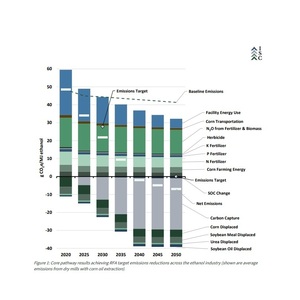Corn ethanol can achieve net-zero carbon emissions before 2050

February 21, 2022
BY Renewable Fuels Association
Following a pledge by members of the Renewable Fuels Association to achieve net-zero carbon emissions, on average, by 2050 or sooner, a new report released today shows that new and emerging technologies and practices could help the industry achieve this vision well before mid-century.
“Last summer, RFA’s member companies adopted a bold vision to achieve a net-zero carbon footprint for ethanol by 2050 or sooner. This new study shows that, with the right policy and investment signals in place, we can reach that objective sooner than 2050 and could even be producing carbon-negative ethanol by mid-century,” said RFA President and CEO Geoff Cooper. “The ethanol industry is already halfway down the road to net-zero emissions, as today’s corn ethanol cuts GHG emissions by about 50 percent compared to gasoline. This study provides the roadmap for completing the second half our journey to carbon neutrality.”
The new report, Pathways to Net-Zero Ethanol: Scenarios for Ethanol Producers to Achieve Carbon Neutrality by 2050, was prepared by lifecycle analysis expert Isaac Emery, Ph.D., of Informed Sustainability Consulting LLC.
“By surveying over two dozen potential emissions reduction actions throughout the corn ethanol supply chain and prioritizing them by technical feasibility, scale of emissions reduction, and cost, this study presents a series of pathways to net-zero CI [carbon intensity] corn ethanol by 2050,” Emery writes. “Updated lifecycle emissions forecasts of corn ethanol from 2020 through 2050 show that the industry can achieve net-negative CI ethanol by adopting near-term technologies and expanding best practices in corn farming.”
Advertisement
The report identified several actions that would constitute a “core pathway” to net-zero emissions:
•Renewable energy use by corn and ethanol producers;
•Expanded adoption of corn kernel fiber fermentation at dry mills;
•‘Better-than-business-as-usual’ industry-wide efficiency improvements and ethanol yields;
•Carbon capture and sequestration by ethanol facilities; and
Advertisement
•Expansion of conservation tillage and other low-carbon practices by corn growers.
Altogether, the study identifies five distinct pathways to net-zero corn ethanol by 2050, based on a set of 28 emissions reduction actions that were considered. The roadmap will be featured and discussed by Emery and others at this week’s National Ethanol Conference, taking place Feb. 21-23 in New Orleans.
The new study can be accessed here.
Related Stories
In a rapidly evolving energy landscape, the 41st International Fuel Ethanol Workshop & Expo will return June 9–11 to the CHI Health Center in Omaha, Nebraska. The event is recognized as the largest and longest-running ethanol conference in the world.
The U.S. EPA on April 11 reported that 1.82 billion RINs were generated under the RFS in March, down from 1.93 billion generated during the same month of 2024. Approximately 5.34 billion RINs were generated during the first quarter of 2025.
The U.S. EPA on April 17 published updated SRE data showing that five new SRE petitions have been filed under the RFS during the past month. According to the agency, 161 SRE petitions are currently pending,
The Iowa Biodiesel Board and Iowa Soybean Association on April 11 issued a statement expressing deep appreciation to Gov. Kim Reynolds for her biofuels advocacy. Reynolds on April 11 announced that she will not seek another term.
Metro Ports on April 8 announced significant environmental milestone in its voluntary efforts to reduce greenhouse gas emissions. By switching to renewable diesel, the organization reduced its carbon emissions by 85%.
Upcoming Events










